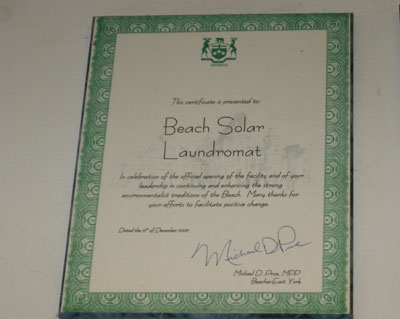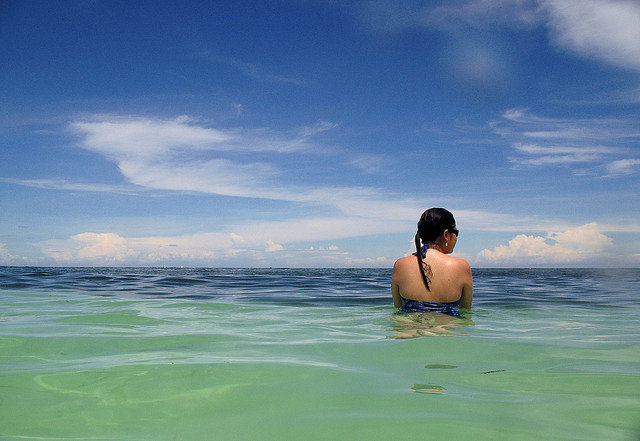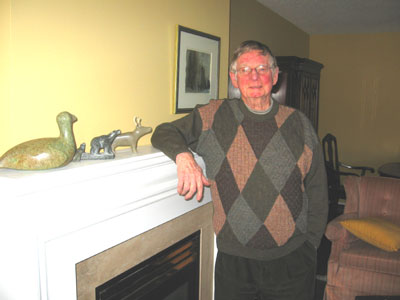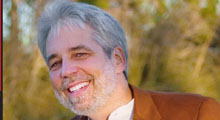Over the last couple of years I have had the opportunity to interview many interesting personalities: tourism experts, authors, philanthropists, and enlightened entrepreneurs. For my article series about Toronto’s Beach neighbourhood, I have specifically been looking to interview business owners who have come up with socially and environmentally innovative business ideas.
Michael Prue, the Provincial Member of Parliament for the Beaches / East York, pointed me in the direction of Alex Winch, owner of the Beach Solar Laundromat. You might think – a laundromat, how can that be an interesting business? Well, read on and you will see that this business and its owner are definitely outside the norm.

Alex Winch explains his solar technology
Early this cold Thursday morning I met Alex at his premises on Queen Street East and got an introduction to this unusual business. When Alex bought the laundromat in 2002 it was outdated and dingy, so Alex got to work and replaced almost half the washers and dryers with new high-efficiency machines. He also put the place through a complete cosmetic overhaul and brightened it up considerably.
But where it gets really interesting is behind the scenes, where the entire operational process of the laundromat was redesigned. Alex always wanted to turn this business into a leading-edge environmentally sustainable business. So in October of 2002 he ordered eight solar panels which were commissioned in December of 2002. Alex had planned all along to use solar energy for heating the water needed in his laundry facility.
Alex explained that the eight solar panels on his building’s roof measure about 250 square feet and were installed by a company named Solcan, located in London, Ontario. The thermal panels include a layer of black copper with a four inch copper vane that contains a three/eighth’s inch copper tube with antifreeze flowing through it. This antifreeze consists of food-grade propylene glycol and transfers the heat energy from the roof through the entire system down to a heat exchanger in the basement. Even if there was a leak in the antifreeze conduits, this would not contaminate the water supply.
The anti-freeze has a freezing point of -25 degrees Celsius at which point the glycol gels, shutting down the solar water heating system since the glycol simply stops moving inside the tubes. In this case a natural gas backup boiler system kicks in and starts heating the water.
In the interest of making his business more environmentally sustainable, Alex has also replaced the lighting system and installed new high-efficiency fluorescent tubes that are under an aluminum reflector. The reflector essentially doubles the light output of the actual fluorescent tubes. Combined with high-efficiency electronic lighting ballasts, this measure alone has resulted in lighting energy savings of 72%. Alex adds that these energy-conservation measures are important since the lights in his business are on for 18 hours a day, 7 days a week.

Alex points to the air handler
One of the first things that Alex explained to me was an air handler above the door which draws warm moist air in from the Laundromat, runs it through coils and dehumidifies the air. The condensation is captured and gets transferred through a pipe system into a basement drain. The condensate water is not re-used in the laundromat out of concern for lint contamination of the water.
To illustrate the operation of his company’s solar water heating system, Alex took me into the basement where he showed me an assortment of water tanks, piping and sophisticated measuring equipment that calculates the actual energy output and natural gas displacement provided by this solar water heating system.
In the basement there are two different water heating systems: the solar heating system that works with a heat exchanger and a 200 gallon warm water storage tank, and a backup natural gas heating system that uses a natural gas boiler with a separate a 100 gallon hot water storage tank. The separate 100 gallon storage tank replaces two 200 gallon storage tanks that were previously used. The new natural gas boiler can heat 100 gallons of water in seven minutes, and this new smaller and more efficient system provides “just-in-time” water heating, and only heats water when needed. The additional benefit of this system is that it stores a much smaller quantity of hot water which significantly reduces energy losses from water storage.
The building’s brick chimney was knocked down to roof-level and now serves as a conduit for the pipes holding the glycol that circulates up to the solar panels on the roof. From the panels the heated glycol then travels back down to the basement, passes through a heat exchanger and heats the hot water for the laundry facilities. A second heat exchanger heats water that circulates through the radiators and provides the space heating for the building. An air conditioning system links three different air handlers in the building The water temperature for the laundry is 120 degrees Fahrenheit (about 55 degrees Celsius) which is just enough to dissolve laundry soap, resulting in no additional heat loss.
All the heating and cooling processes are controlled by thermostats, and a sophisticated measurement system calculates how much natural gas has been saved by using solar energy. This measurement system is connected to a website on the Internet (www.bslvideo.com) which provides live energy monitoring to anybody who is curious.

The processes explained at the Beach Solar Laundromat
The website also provides a “live laundry cam” that allows customers of the Beach Solar Laundromat to see how busy the Laundromat is. Alex has installed a low-resolution camera to improve customer service so his clients can conveniently check from home when a good time for doing laundry would be. A second high-resolution camera, whose images are not publicly available, was installed for security purposes since the laundromat is not regularly staffed. Some of the clients were originally concerned about the cameras’ intrusion on their privacy, but once Alex explained that the low resolution cameras would not provide sufficiently clear pictures to identify them (or their dirty laundry), those concerns were alleviated.
Obviously Alex has a great connection to technology, and as he was trying to explain the intricate details of his solar heating system to me – a total novice to things such as heat exchangers and volumetric flow meters – I asked him if he was an engineer. He explained that he graduated in 1985 from engineering physics at Queens University. Four years later he added the designation of chartered financial analyst to his resume and set up his own company to sell research about Canadian stocks to US hedge funds. In 1990 he started his first hedge fund which was followed in 1993 by the opening of an office at 667 Park Avenue in New York City. Based on his success, he retired in 1995, an event he refers to as “Freedom 31”.
After that point he became a major shareholder in a casino company, volunteered as head of investor relations and became the Chairman of the Board. Alex was not happy with the way things were run at that company and demanded that various changes be made. When management did not respond to his concerns he left in 2002 and launched a hostile proxy fight threat, in other words he threatened to take over the company. Alex had talked to all the shareholders, and they were prepared to vote for change. Alex demanded that the President resign or he was going to “kick him out”.

An award to the Beach Solar Laundromat




